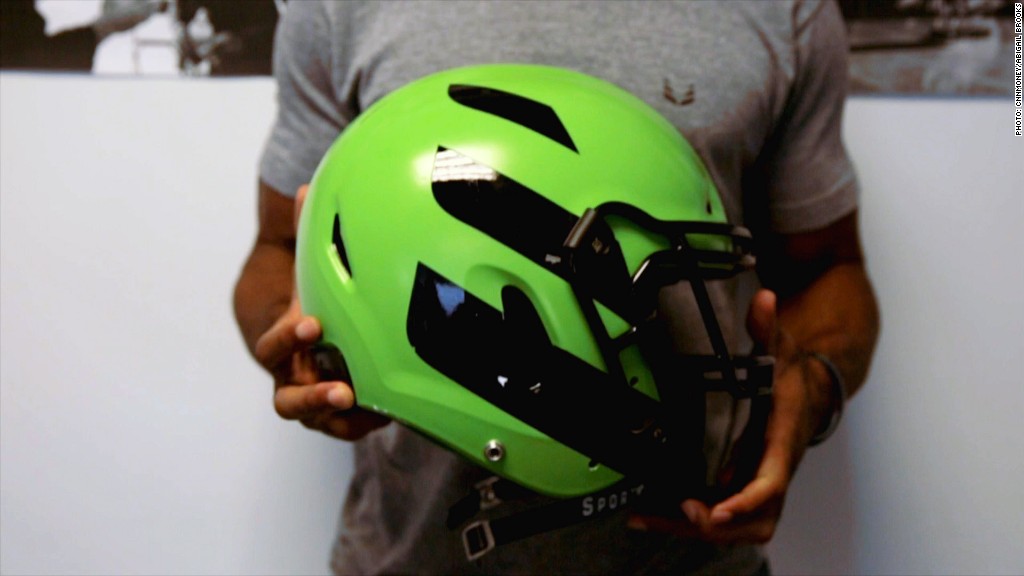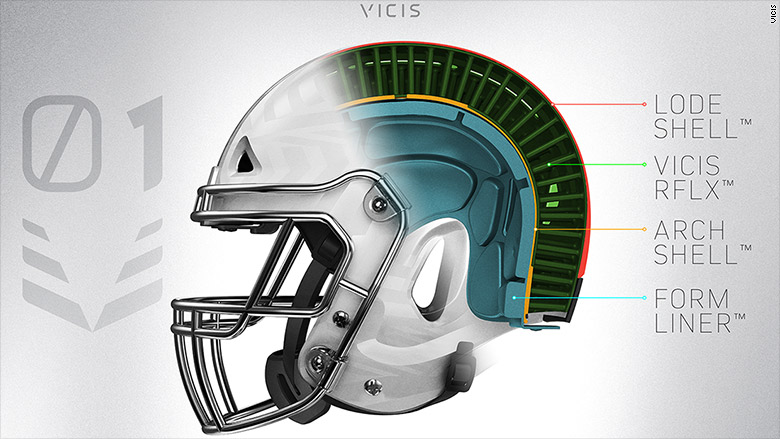
In the 1920s, football players wore soft leather helmets. Ten years later, helmets were made of hard leather. By the 1970s, players were sporting hard plastic helmets.
Nearly 50 years later, players are still wearing basically the same plastic helmet.
"What I wore when I was playing little league football is almost close to what I'm wearing now as a professional athlete," said Seattle Seahawks wide receiver Doug Baldwin. "There's not really much available in terms of the innovation for safety."
As concussions have riddled the sport and raised questions about the long-term effects of playing football, improving helmets is finally becoming more of a priority.
Related: Football is pitting your cell phone against your television
VICIS, a company based in Seattle, is hoping its helmet can help make the game safer for players.
"Right now we can demonstrate and prove that we can reduce impact forces, and we can do that better than any helmet on the market," VICIS CEO and cofounder Dave Marver said.
But, VICIS is clear that nothing -- not even its helmet -- can prevent concussions.
The VICIS Zero1 lessens the force of blows to the head by offering four layers of protection. There's an outer layer that deforms to absorb shock and then rebounds, a layer of polymer columns that move in multiple directions to reduce force, a hard inner shell to prevent skull fractures and brain bleeds, and a layer of memory foam for comfort.
It is slightly heavier than current helmets on the market.

VICIS cofounder and pediatric neurosurgeon Sam Browd said it was a real challenge to reduce impact in the narrow space between the outside of a helmet and a player's head.
Browd used the example of a car getting into an accident: The front of the vehicle crumples to absorb the impact, then gets repaired or discarded. A helmet has to take a major blow and not get damaged.
"We're trying to slow down this energy over about an inch and a half," Browd said. "This product has to absorb the energy and then be ready to do it again a couple milliseconds later. It's been a very significant engineering challenge to overcome some of those obstacles to end up where we're at now."
Related: Pittsburgh Steelers' new robot could prevent injuries during practice
VICIS is currently working to fill orders from several NFL and collegiate programs. It was testing its helmet out with two college teams, but had to pull it back because of fit issues. It expects to have players wearing the helmet in games later this season.
VICIS received a small amount of funding from the NFL as one of its Head Health Challenge winners, but VICIS has since raised $20 million on its own.
The company was founded and is run by scientists, neurosurgeons, and engineers. It also has a roster of current and former NFL players, including Tony Dorsett, Jerry Rice and Roger Staubach, who serve as consultants.
"We're dealing with something right now that is threatening the future of our sport," Baldwin said. "The mentality in the sport, it's 'suck it up. ... We're reaching a point now where 'suck it up' is just not enough. We're going to suck it up, but at the same time that doesn't mean that we can't have innovation to help our safety."
Baldwin, who's also an investor in VICIS, said he doesn't plan to stop playing, but he wants a safer helmet since he's had numerous concussions.
"I went up for a catch, landed on my head," Baldwin said of his worst concussion. "I got up and I couldn't recognize where I was. I knew I was on the practice field. However, I didn't know where my teammates were, where my coaches were, where the exit to the field was. I was lost."
Related: NFL picks Washington D.C. police chief to head security
"The more concussions you have, the worse it is for your brain," said neurologist Barry Kosofsky. "You want to minimize the injury in your brain, and you want to minimize the number of concussions to your brain, but nobody can say how many is too many."
One of the concerns for players who have suffered multiple concussions is the risk of developing a degenerative disease called chronic traumatic encephalopathy (CTE).
Related: New York Times hits back at the NFL
VICIS' $1,500 helmet is currently only available to pro- and college-level teams. The plan is to eventually make it available to kids and the general public at a more affordable price.
"There's certainly going to be communities out there where a helmet, no matter what price point we come in at, is going to be maybe too expensive," Browd said.
"Whatever kids feels like they want to be in our helmet, and would think our helmet's safer, I'm going to make sure that they get the helmet. ... Just like you can go and buy a car today and every car has an air bag and some of the safety, no matter what price point you're at."
